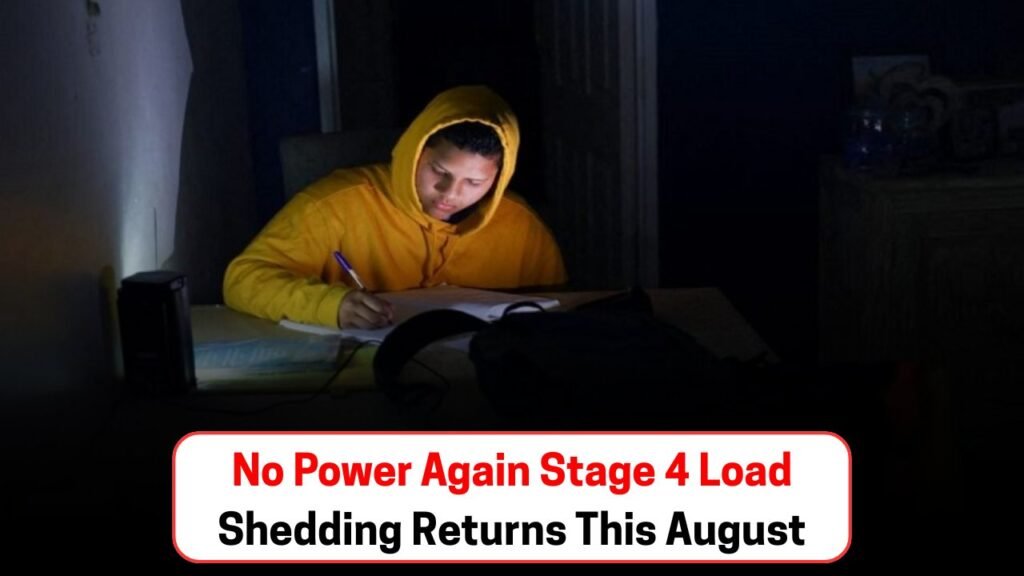Stage 4 Load Shedding in South Africa: This August, South Africa finds itself grappling with the challenges of Stage 4 load shedding yet again. As power generation struggles to keep up with demand, citizens across the nation are preparing for scheduled outages that will affect daily life. Load shedding, a term familiar to many South Africans, involves planned power cuts to prevent the total collapse of the national electricity grid. The ongoing energy crisis underscores the need for sustainable solutions and effective management by Eskom, the country’s primary electricity supplier. With the current situation, individuals and businesses alike are bracing for the impact, adjusting their routines to accommodate the power cuts. Understanding the schedule and the areas affected is crucial for minimizing disruption.

Understanding Stage 4 Load Shedding in August 2023
Stage 4 load shedding in August 2023 is characterized by rotational power cuts, where electricity supply is intentionally reduced in certain areas to balance the national load. This stage typically involves power outages lasting up to four hours at a time, with multiple outages potentially occurring within a single day. The primary aim is to prevent the grid from becoming overloaded, which could lead to widespread blackouts. During this period, Eskom is expected to shed approximately 4,000 megawatts of electricity from the national grid. This level of load shedding is often triggered by unforeseen circumstances such as plant breakdowns, maintenance issues, or increased electricity demand during peak times. For residents and businesses, staying informed about load shedding schedules is essential. Eskom and local municipalities regularly update their load shedding timetables on their websites and through various media channels, helping citizens plan their activities and reduce inconvenience.
Area-Wise Impact of Stage 4 Load Shedding
The area-wise impact of Stage 4 load shedding is extensive, affecting both urban and rural regions in South Africa. Major cities like Johannesburg, Cape Town, and Durban are not immune to these planned outages, with each area following a specific schedule to ensure equitable distribution of power cuts. In Johannesburg, for instance, residents in neighborhoods such as Sandton and Soweto may experience different outage times based on their designated load shedding blocks. Similarly, in Cape Town, areas like the CBD and the Southern Suburbs follow a structured timetable, allowing residents to plan accordingly. Rural communities, often more vulnerable due to limited access to alternative power sources, are also impacted. For these areas, load shedding can disrupt essential services such as water supply, communication networks, and even healthcare facilities. To mitigate these effects, many households and businesses are investing in backup power solutions like generators, solar panels, and UPS systems to maintain some level of normalcy during outages.
Strategies for Coping with Stage 4 Load Shedding
Coping with Stage 4 load shedding requires strategic planning and adaptation. One effective strategy is investing in alternative energy sources. Solar power, for instance, is gaining popularity as a sustainable and cost-effective solution for reducing reliance on the national grid. By installing solar panels, households and businesses can generate their own electricity, reducing the impact of load shedding. Additionally, energy storage solutions such as batteries can store excess power generated during the day for use during outages. Another approach is to implement energy-saving measures to reduce consumption. Simple actions like switching off unnecessary lights, using energy-efficient appliances, and unplugging devices when not in use can collectively make a significant difference. Businesses can also consider flexible working arrangements, allowing employees to work from home or outside of peak load shedding hours to maintain productivity. Community initiatives, such as sharing resources and supporting each other during outages, can foster resilience and solidarity during challenging times.
Government and Eskom’s Role in Addressing Load Shedding
The role of the government and Eskom in addressing load shedding is crucial for finding long-term solutions to South Africa’s energy crisis. The government, in collaboration with Eskom, is responsible for implementing policies and strategies to improve electricity generation and infrastructure. This includes investing in renewable energy projects, such as wind and solar farms, to diversify the energy mix and reduce dependency on coal-fired power stations. Additionally, upgrading existing power plants and building new facilities can enhance capacity and reliability. Eskom’s role involves maintaining and operating the national grid efficiently. By prioritizing maintenance and reducing breakdowns, Eskom can minimize the frequency and severity of load shedding. Transparency and communication with the public are also vital. Providing timely updates on the status of the grid and load shedding schedules helps manage expectations and reduces frustration among citizens. Ultimately, a concerted effort from both the government and Eskom is necessary to address the underlying issues and ensure a stable and sustainable energy future for South Africa.
How can South Africans find the full list of areas affected by load shedding?
By checking the provided area-wise list for August's Stage 4 load shedding.









